Rush’s ‘Roll the Bones’: How Theme of ‘Chance’ Inspired Cover |
Written by Beth on January 8, 2021
Neil Peart‘s lyrics on Roll the Bones are loosely themed around the idea of “chance,” and art director Hugh Syme expanded on that broad concept with his cover for Rush‘s 1991 LP.
His logical starting point was a game of chance: dice. But he twisted the album’s titular phrase into a more unsettling, if bleakly humorous, image.
“‘Bones’ was slang for dice because dice are made of ivory,” he tells UCR. “I’ve always been fascinated with the juxtaposition of youthful innocence and inevitable mortality, like having a kid playing kick the can — but with a human skull.”
The cover shows that young boy, leg extended, standing mere feet from the skull. He’s walking on a platform next to water, positioned in front of a wall of dice that spells out “rush” in black pieces. “Knowing I wanted dice for the tiled subway wall behind the boy, I decided to build a subway platform with water,” Syme says. “These things just occur as you proceed through a project.”
As usual, the art director got his hands dirty to create the image, building “a big frame” that measured 20′ x 16′. “It came to a point where the camera sat almost at water level,” he recalls. “We sandbagged this big 2 x 12 board frame and had the carpenters come in and make it so we could drape very carefully fused black vinyl over the whole thing. [Photographer] John Scarpati’s studio was formerly a brewery and distillery, so all the floors were originally structurally sound enough to roll huge barrels of ale.
“We built the subway platform out of 2 x 4s,” he continues. “I used a water-proof Foamcore [Sintra], and I painted that and texturized it to look like a concrete walkway. The background wall was a miniature that I created out of dice, which I painted and distressed [then] introduced into the scene later. The weeds and all the detail were brought in so they could be photographed in-camera at the time the boy walked across the stage. Of course, we wouldn’t rely on the boy to successfully repeatedly kick the skull, so the skull was shot as a separate element and stripped in later. This all took place right on the threshold of Photoshop’s genesis, so that was all done digitally.”
In a January 1994 installment of Rush’s Backstage Club Newsletter, Peart wrote that the cover “reflects a style of 17th-century Dutch painting called vanitas, in which symbols, such as the skull (and also candles, books, flowers, playing cards, etc.), were used to remind the good Netherlanders of life’s brevity, and the ultimate transience of all material things and sensual pleasures.”
But Syme denies intentionally channeling any such style.
“I don’t see any kind of ‘Vermeiren Dutch Master’ attributes in that piece,” he says. “The edge lighting on the boy looks like that, but it certainly wasn’t my intent. Maybe it was an afterthought, an observation — by some — in hindsight.”



